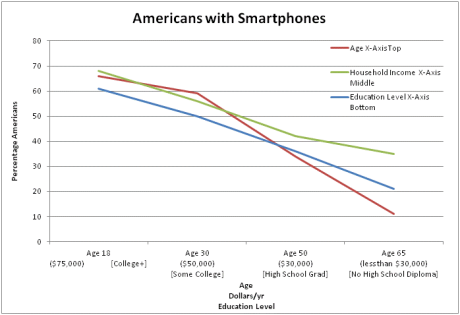After viewing a report on smartphone ownership, I decided to create a chart with the data in the report. I documented The percentage of people who own smartphones with respect to age, Income and Education Level. Both Income and Education Level are in descending order while Age is in ascending order. These are not the only elements that the report recorded. But those seem irrelevant to the general trend. Those quantities include gender (50/50) and Race (50% for Whites, Hispanics and Blacks). One criteria that I did not include but did contribute to the trend was geographic location. But as one would expect, people in urban (48%) and suburban (49%) areas own more smartphones than those who live in rural areas (29%).
To explain the graph in its most basic form, the younger (though not younger than 18) , richer, more educated a person is, the more likely they will possess a smartphone. This should make perfect sense because smartphones is a very 21st century trend. The general population born in the ’90s experienced the development of the smartphone just as they are at their peak of learning capacity. As a result, 2/3 of the people between ages 18-29 own smartphones.
Another component to this is wealth. Let’s be honest, smartphones are quite expensive in comparison to the basic tool of communication it used to be. It has evolved a long way and can achieve a number of goals with just a few swipes and clicks. The amount of effort put in to develop this mini-computer has been phenomenal in the past 2 decades. But because of that very effort, not everybody can afford this luxury. The more wealthy a family, the more likely their child will have a smartphone. Intuitively, the level of education is also connected to wealth, more so than the smartphones even. This works both ways though. On one hand, the more wealthy a family is, the better the education their kids will receive, and they will mostly likely reward their child with a smartphone for a birthday or some other occasion, perhaps graduating middle school. On the other hand, the better of an education a person receives, the better the job he/she will get. And a better job means a better salary and income, which will ultimately lead to a more adept communications tool: the smartphone.
Even though these element show a very consistent and uniform trend, this does not mean the inverse of this trend is true. To elaborate, owning a smartphone does not make a person wealthier (they may appear wealthier), it does not make them more educated (one could argue that a smartphone is a good learning tool), and it certainly does not take any wrinkles of one’s face. So do not be mistaken. At the end of the day, education is still the ladder to the top, and the smartphone is just a small stepping stone along the way.
http://www.pewinternet.org/Reports/2012/Smartphone-Update-Sept-2012.aspx

